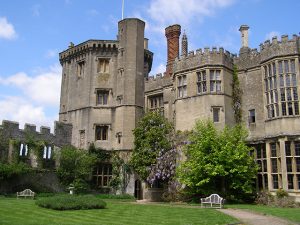‘For herein may be seen … murder, hate, virtue, and sin.’
Was the term sentencing a man to death used in Richard III’s reign? If a fictional character said the Duke of Clarence had a brain like a pickled walnut, were walnuts around in 1470, let alone pickled? What colour was his duchess’s hair? When was velvet invented? If a knight whistles up his horse and springs from an upstairs windowsill onto the saddle, will it ruin his chance of fatherhood?
Yes, you’ve entered the world of the historical novelist. Infotainment! Our task is to enthral and enlighten you, and within a few pages have you believing you are back in an earlier century with its smells and superstitions, splendour and rags. It requires effort: characters must be fleshed out, sets designed, places visited plus there’s lots of research. It’s like a one-man film studio. The novelist becomes the historical advisor, screenwriter, casting agent, costume and set designer, location finder, vocal coach, sandwich-maker and director in one package.
Establishing the facts, historical novelists browse the university shelves for primary sources, seek out biographies of the breakers and shakers (you can’t have Warwick the Kingmaker feasting at Westminster on 28 March 1461 when he is slaying his destrier at Ferrybridge) and chase up journal articles. We may email an expert, phone a university Classics Department to get a Latin quote right, beg the local heraldry wiz to dream up a surcoat device, consult a tame doctor on abscesses or the corner chemist’s book on poisons.
Illuminated manuscripts, Books of Hours and medieval artworks help with descriptions. The detail showing a well-dressed servants sleeve tippets sensibly looped up behind his back so he can easily serve his lord at the feast – perfect!
The number of areas where some research is needed can be daunting if you strive for authenticity. Take women’s clothing; knowledge of style, fabrics, dyes and accessories is needful. Do garters really keep her stockings up? How is her clothing fastened and – with sex scenes in mind – unfastened? Are her garments comfortable or restrictive? Imagine wet skirts flapping round your ankles. (Gentlemen, if you were wearing a houpelande, you’d experience this, too.) What does her clothing say about her marital status or calling? Does the weight of her headdress give her a megrim or pull her head back?
The same applies to male clothing. Think what the lads might have carried in their sleeves: frogs, prayer-books, loveletters, daggers. How did the hose attach to his gipon? Does he put on armour? If so, what style? Does he wear the Yorkist rising sunne or the Oxford sterre?
Then there are horses and their paraphernalia , a castles layout and terminology, food, necessities, furnishings – the list is endless. How far could a man travel in a day depending on his transport/footwear, health, the state of the roads and the weather, not to mention his possible ignorance of the terrain? Do the characters know whether the world is round or flat? Does the hero believe that if he gives his wife pleasure during their love-making, she is more likely to bear a worthy son, or does he worry about Hildegard of Bingen’s warning that too much unbridled lust will make him go blind? What music does he hear? What stories does he know? He would know of Bathsheba, but will young, secular readers understand the reference? Can he ‘play cards close to his chest’ at Richard III’s Westminster?
Novelists have to decide whether to make it easier for readers and opt for contractions in the dialogue or stick to ‘cannot’ and ‘shall not’? According to the Oxford English Dictionary, the first written mention of ‘tisn’t’ is 1803!
The use of an anachronism like ‘charade’ in a thirteenth century setting can bring the reader back to their living room with a jolt. Even authentic words can have too strong a modern meaning. Prototype (from the 1550s) sounds very recent. Some words have changed their meaning, too. If a knight puts on his bassinet and picks up a faggot, could this be misconstrued?
Sometimes today’s world provides insights. For me, hearing someone in Herefordshire complain about his sports car’s tyres being slit by yobos in Snowdonia made me think more deeply about what it might have been like to be an Englishman in Brecon in 1483. Adding the layer of Welsh resentment and the acts of vandalism gave extra realism to a novel set in the Duke of Buckingham’s household.
Experiencing actual locations, too, flows through to our writing: glimpsing the swallows’ nest beneath the parapet, the houses in the cliffs at Amboise, the view from the castle battlements at Angers or Richmond, Yorkshire.
Most of the huge amount of information that novelists collect ends up on the cutting room floor. Some of it gets sanitised. Today we might play down superstition, religious devotion, hunting and bedbugs. None of ‘You’re looking beautiful tonight, Mistress Shore, murmured King Edward, plucking a flea from one of her tresses.’
Well-researched historical novels can permit conjecture in ways denied to academic historians. For example, creating a novel allowed me to suggest that Warwick’s bastard daughter, Margaret Neville, was the anonymous lady spy of Calais. Such a hypothesis is possible for, in honesty, fifteenth century history is little more than gossip in letters and scraps of records pieced together by the professionals to form text books, and what clouds the truth even more is that contemporary histories, just like bestiaries, were designed to teach morality – and written by the winners! Virgil, Hall and Holinshed’s works were not just biased but didactic. ‘All is written for our doctrine, and for to beware that we fall not to vice,’ agreed Caxton.
Most history books seem to forget women existed. Just because the Croyland Chronicler doesn’t say so doesn’t mean the duchess and her ladies weren’t present in the great hall. Novels also permit us to put emotion back into history and explore personal interactions, such as the growing rift between Richard III and ‘him who had best cause to be true’.
At the end of all the novelist’s labour, the manuscript must be marketable, supply a setting acceptable to the publisher and a high concept that the sales reps can grasp easily so they can enthuse to the bookshops or the buyer for that Big Supermarket. The author must engage the editor/reader within the first few pages and keep her/him hooked with the pace, suspense, humour, emotional tension, sex, zesty dialogue, believable characters and lively narrative.
Now, finally tell me, is it through history textbooks or a well-researched novel that you smell the roses, the ditches and the spilt blood of the Middle Ages?





